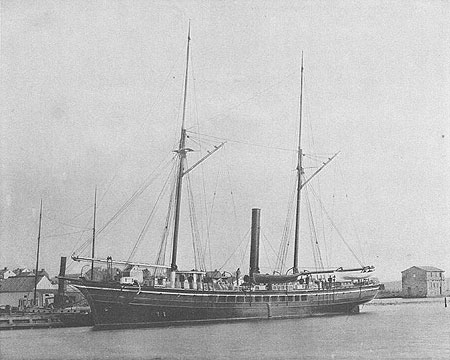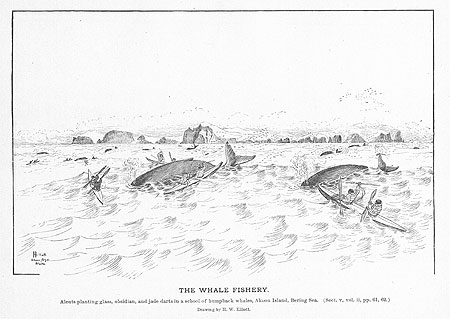NOAA's Collection of Rare 19th Century Oceanography Books
This collection features 19th century rare books that are part of the larger NOAA Central Library Rare Book Room and which capture the spirit and accomplishments of the formative years of oceanography. The volumes are diverse, including official accounts and results of oceanographic cruises, descriptions of traditional and new technologies, personal reminiscences, the first English-language textbook of oceanography, and even a German-language volume selected for the beauty of its presentation, as much as for its content. Many of the authors were among the "founding fathers" of modern oceanography.

Ferdinand Hassler, the first superintendent of the U.S. Coast Survey, gathered books for the original Coast Survey Library beginning in 1811 and inscribed them with the words shown above.
Oceanography is a relatively new science. Once known as "oceanology" or "thalassography," its early beginnings are lost in the lore of the mariners and fishermen who first ventured out to sea. Both the Greeks and Romans wrote of oceanographic phenomena, but it was not until a few hundred years ago that a semblance of organized knowledge began to appear. Treatises such as Robert Boyle's Tracts consisting of observations about the saltness of the sea…, published in 1674, and Count Luigi Marsigli's Histoire Physique de la Mer (trans. Physical History of the Sea), first published in 1711, were pioneering works associated with this young science. By the mid-19th century, oceanography had matured sufficiently for scientific and biographical literature of the sea to begin to appear. Much of the early oceanography literature resides in the NOAA Central Library's Rare Books Collection in Silver Spring, Maryland.
Beginning in 1811, the Coast Survey Library, one of the ancestor libraries of the NOAA Central Library, began collecting technical books on mapping, charting, and related subjects. In its early years, the Coast Survey was concerned primarily with charting U.S. coastal waters and ports to improve navigation and commercial development. Thus, the Coast Survey Library was mostly comprised of reference books on astronomy and trigonometry. Interestingly, the first Superintendent of the Coast Survey, Ferdinand Hassler, brought back many books on these topics from Europe and inscribed them all in his own hand with the words "Library for the Survey of the Coast."

This online collection features excerpts from three books that document the work of U.S. Coast and Geodetic Survey steamer Blake (above), the most innovative oceanographic vessel of the 19th century. It created the first modern bathymetric chart, introduced wire rope oceanographic operations, anchored in depths over 13,000 ft, and supported studies of the Gulf Stream that are considered among the best oceanographic observations of the 19th century. (pl.1, frontispiece, from Deep-Sea Sounding and Dredging)
Oceanography was not well represented in the original Coast Survey Library until the United States and other countries such as England, Monaco, Germany, France, Norway, and others began more ardently exploring the ocean in the mid-19th century. The scientists and explorers on these cruises often documented their amazing findings and technological advances in very detailed, often lavishly illustrated books.
About this Collection
This collection captures the spirit and accomplishments of the formative years of oceanography. Its books represent the major themes of ocean discovery in the 19th century, including understanding ocean winds, currents, and depths for navigation, charting, and commerce; studying fisheries, a vital aspect of nations' commerce and food supply; acknowledging that oceans are vital for the well-being of nations; and marveling at the awesome power, the majesty, and beauty of the oceans. The authors of many of these books—Maury, Thomson, Agassiz, Silsbee, Mohn, Sars, and Pillsbury—were among the "founding fathers" of modern oceanography.

Drawing by Henry Wood Elliott from The Fisheries and Fishery Industries of the United States. The team of contributors to this profusely illustrated treatise investigated the natural history of 239 marine species and studied fishing techniques and communities throughout the U.S. during the 1880s. (sect. V, pl. 220)]

Deep sea fauna illustrated in the The Depths of the Sea. This volume reported the discoveries aboard the British ships Porcupine and Lightning during the summers of 1868, 1869, and 1870 that disproved the azoic hypothesis that life in the deep ocean did not exist beneath 300 fathoms. On those voyages, explorers dredged in waters over 2,400 fathoms deep and brought back a remarkable array of marine life. (fig. 65)
The books, published between 1839 and 1903, highlight some of the greatest early oceanographic achievements of four seafaring nations—the United States, Norway, Germany, and Great Britain. Their authors reported the findings of ocean expeditions in great detail, including ocean temperatures, icebergs, flora and fauna, celestial positions, technological developments, and native peoples and cultures of foreign lands. Several of the works are multi-volume, reflecting the enormous amount of material and data collected and described.
For this collection, we have assembled excerpts from these pinnacle works. In most cases, full versions of the texts are available online through the NOAA Central Library and can be accessed at the end of each item description.
You can browse through the books in the collection by clicking on the links to the right or click here to view the items in the NOAA's Collection of Rare 19th Century Oceanography Books.










